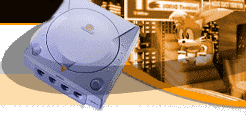| |
JoJo's Bizarre Adventure
Bizarre? They ain't kidding. - Review By BenT
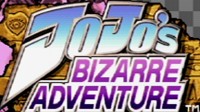 For many gamers, the mere mention of the word "Capcom" evokes thoughts of a rich history of 2D fighting, unparalleled by other companies. Since the introduction of Street Fighter II back in 1991, they've consistantly churned out hit after hit in the newly popular genre. During the early part of their dynasty, Capcom seldom strayed far from the formula which had brought them success. However, gamers began to grow bored with the Street Fighter II series, which seemed to receive For many gamers, the mere mention of the word "Capcom" evokes thoughts of a rich history of 2D fighting, unparalleled by other companies. Since the introduction of Street Fighter II back in 1991, they've consistantly churned out hit after hit in the newly popular genre. During the early part of their dynasty, Capcom seldom strayed far from the formula which had brought them success. However, gamers began to grow bored with the Street Fighter II series, which seemed to receive
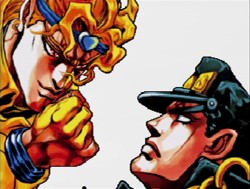
Dios and Jotaro: eternal enemies, and sharp dressers. |
only incremental upgrades. Capcom needed a change of pace, and quickly. This first happened around 1994, in the form of Darkstalkers. It was a well-animated (for the time) fighter that starred various classic creatures of the night, complete with absolutely wicked character designs. It didn't really fall that far from the Street Fighter II tree, but was unusual enough to differentiate itself from Capcom's prior games. Darkstalkers spawned two sequels, and the series' cartoonish art style would later be seen in the Street Fighter Alpha, X-Men, and Versus series.
Another major change occurred when Capcom began collaborating with Marvel Comics, first in X-Men: Children of the Atom and next in Marvel Super Heroes. Both games featured more over-the-top action than had been seen previously, but the best (or worst, depending on your viewpoint) was yet to come. Capcom's next game, X-Men vs. Street Fighter, marked the beginning of what's commonly referred to as the "Versus" series. The control was looser, the combos spectacularly ridiculous, and button mashing was an integral part of gameplay. Gamers ate it up. The series continued with Marvel Super Heroes vs. Street Fighter, Marvel vs. Capcom, and finally Marvel vs. Capcom 2, each being more popular than the last. In fact, Versus could be seen as Capcom's "main" 2D fighting series at this time, since the Street Fighter III games haven't exactly set the charts on fire.
Capcom's success has allowed it to continue experimenting with such variations, and the most recent example is before us today. JoJo's Bizarre Adventure is based on a popular manga series in Japan. The arcade game ran on Capcom's elite CPS3 hardware and has gone through two incarnations so far (JoJo's Venture and JoJo's Bizarre Adventure: Heritage for the Future), both of which are included in this Dreamcast compilation. Still, you'll probably only want to play the newer one, as it has double the characters and near-identical gameplay. Now, the arcade game was a sleeper, at best. Is this game up to snuff for the demanding home market?
The Good
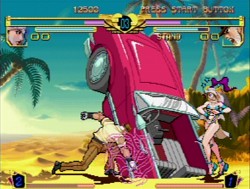
SHORYUCAR! ... Ahem. |
JoJo's Bizarre Adventure lives up to its name in at least one respect - it's nothing if not bizarre. The characters (for the most part) exude originality and style. One of the fighters is a tiny bulldog, while another is a hawk. One character causes classic cars to erupt from the ground to strike the opponent, and even has a bulldozer at her command. Another turns his opponents into children, and then smacks them with huge axes that pop out of the ground in front of him.
How does the game explain all this craziness? Well, each character has something called a Stand, which is sort of a spectral representation of that character's personality. Activating a Stand in battle opens up a host of new abilities which can vary widely, depending on the character. Some Stands are passive, and mainly exist to enhance a characters' attacks. Others are quite active - D'bo's Stand is like a second character, which you can control in concert with him for some deadly two on one action! Awesome stuff.
JoJo's features 16 standard characters and at least 5 hidden ones, so the cast count is pretty decent for an original 2D fighter. Most of the characters are fairly unique, and play quite differently from each other. That's always a huge plus for a fighter - who wants to play a game populated with seventeen slightly different Shotokan clones? Again, most of this variety is due to the aforementioned Stand system. While the effects of the Stand vary from character to character, a few things are universal: having the Stand activated increases offensive power, and allows you to
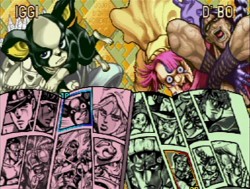
The first fighting game in which a dog is prominently featured? Probably. |
perform simple 1-2-3 chain combos. Most, but not all characters have a Stand meter, which represents the vitality of their Stand. If the Stand takes too much damage and the meter empties, their guard will be broken and the Stand must be allowed to regenerate before it can be summoned again. Other characters have more unique wrinkles - for example, activating Mahrahia's Stand causes a switch to appear. If her opponent makes contact with it, she "levels up", and her attacks do more damage. Touches like this are both innovative and interesting.
Sound is standard bland Capcom fare, with nothing being particularly bad or great. It's worth noting that the tunes are somewhat more listenable than in other recent Capcom fighters (*cough*MvC2*cough*), but I doubt you'll be humming them around the house any time soon. However, they're still quite servicable, as are the sound effects.
As you would expect for a Capcom fighter, the control is hot and tight (that meaning "precise", if you don't work at GameSpy..). Typically, the standard Dreamcast directional pad is a bit lacking when it comes to pulling off special moves, so you may want to invest in a Mad Catz, ASCII FT, or other fighting-type pad to enjoy the game to its fullest. Modes are also par for the course - you have Story and Versus in both games, and JoJo's Venture has a typical Survival mode. In JoJo's Bizarre Adventure, Survival is replaced by the similar Challenge mode, in which you earn points for quickly defeating foes. It's in this mode that you can unlock the secret characters, if you meet certain requirements.
Finally, I must say something about JoJo's presentation - it's really top notch. Both games utilize a comic book motif, which is appropriate since the series originated as manga. The opening of JoJo's Venture is particularly rockin', with excellent character artwork and a cool "flying into comics" effect. Even the character selection screen sports this style - each character's box looks like a comic's illustration panel. Slick.
The Bad
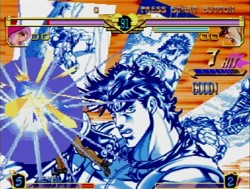
A super move. I think you can almost make out the two characters among all that madness. Almost. |
The worst thing about JoJo's is that there's just not much depth to it. Capcom has adopted a new control scheme for the game: you have weak, medium, and strong attack buttons, plus a button to toggle your Stand on and off. That's it. The new layout, while easy to learn, really limits the amount of moves each character has. In fact, provided you have a move list, it's not hard to become fairly proficient with a character in the space of thirty minutes. There are a few interesting gameplay systems to master, such as Advancing Block (pushes your enemy away during your block) and Guard Cancel (duh), but their use is so simple you'll have them down in no time. This lack of depth will cause some players to drop the game rather quickly, no doubt, as they won't feel they have much more left do after unlocking the secret characters and seeing all the "wacky" special moves.
I'm sort of split on the graphics - they're rather perplexing. Seeing as this game ran on the highly regarded (performance-wise, anyway) CPS3 hardware, one would think the animation would be pretty astounding. To be sure, certain sequences (like Midler's bulldozer move) look pretty darn smooth. Unfortunately, they're the exception and not the rule. Most of the animation in JoJo's Bizarre Adventure could have easily been done on CPS2, which is not a terrible crime in itself. (And it's worth mentioning that it looks as if all of the arcade animation made it here into this port.) What is lame is that certain moves are totally lacking in adequate animation - Joseph's run comes to mind as an example. It looks terrible when compared to some of the game's better animations, and seems quite out of place. But really, I'm nitpicking here. An inadequate number of frames here and there is not going to ruin your fun.
JoJo's other, more serious graphical shortcoming is that everything looks very, very pixelated. Think of it as sort of a 2D version of the Playstation 2's notorious "jaggy" effect. Why this occurs I'm not sure - my best guess is that the arcade game ran in a different resolution than this home port, so throwing the arcade's source art directly onto the Dreamcast screwed up the aspect ratio. Whether I'm right or not, one thing's for sure: this inexplicable blockiness really takes away from the overall splendor of JoJo's graphics, often making them look fairly rough.
The Final Word
JoJo's Bizarre Adventure is a fairly decent package for the 2D fighting fan. It brings a bunch of new ideas to the table, and combines them with some genuine style and sharp character design. The gameplay's relative lack of depth will hurt the long term lifespan of the game, but it's still an unusual and entertaining cross between Street Fighter and the versus series.
Developer: Capcom
Publisher: Capcom
Genre: 2D Fighting
Highs: Solid gameplay, cool variety of well-designed characters, lots of style.
Lows: Lack of depth, strangely blocky graphics, slightly lacking in animation.
Other: 1-2 Players, VMU Compatible (4 blocks), Jump Pack Compatible, VGA Cord Compatible, Arcade Stick Compatible.
|
Final Score:

(out of a possible 10)
|
Visit this Game's Dreamcast Database Entry
Previous Reviews
Comments on this review? Mail Feedback.
|

